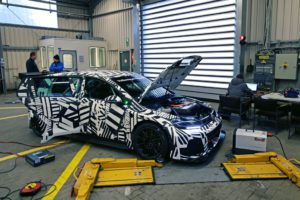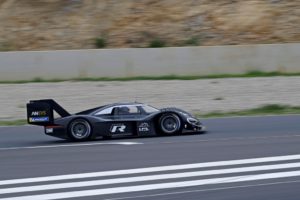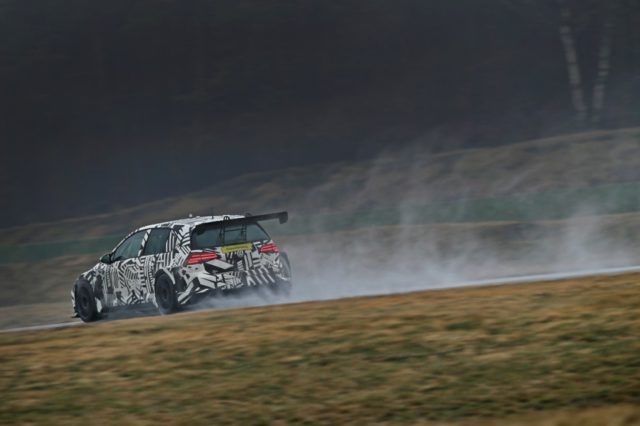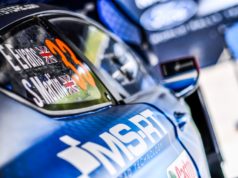It was all over after exactly 7:57.148 minutes. With Romain Dumas at the wheel, the I.D. R Pikes Peak crossed the finish line in the world’s most famous hill climb. A record-breaking sprint that lasted 19.99 kilometres, preceded by numerous tests over a distance of 4,000 kilometres – spread over six months.

The I.D. R Pikes Peak project got the green light in September 2017. After that, the first fully electric race car from the Volkswagen Motorsport development department started to take shape on the computers of the development department. In order to make use of the time available until completion of the I.D. R Pikes Peak, the technicians converted a Golf GTI TCR from the touring car department of Volkswagen Motorsport to use a twin-engine electric drive system with around 400 kW (544 PS). “We used this car for around 15 days in January 2018 to gather data at the Volkswagen test site in Ehra-Lessien. Being able to use the test site was a great help,” explains Fabrice van Ertvelde, project engineer for the I.D. R Pikes Peak at Volkswagen Motorsport, as he describes the good level of cooperation with colleagues from Volkswagen Technical Development.
Alongside Dumas, Volkswagen development driver Dieter Depping also chalked up some kilometres at the wheel of the electric race car in Ehra-Lessien. “It was all about researching the basics,” explains Depping. “The electric drive system was a new area of activity for Volkswagen Motorsport. We had to understand how the individual components work together in a race car, and what the ideal configuration would be.”

Rollout after the World Premiere
Volkswagen Motorsport passed one milestone on 22 April 2018 – the I.D. R Pikes Peak made its official appearance on the racetrack just outside the town of Alès in the south of France. “After the rollout, we tested there for four days,” recalls van Ertvelde. The engineers needed to try out different setup scenarios for the suspension and the aerodynamics. Alès is Romain Dumas’ home circuit. The 40-year-old driver had also prepared there ahead of his three previous Pikes Peak victories. “This allowed us to make valuable comparisons between the results with the I.D. R Pikes Peak and Romain’s data from previous years,” says van Ertvelde.

The motorsport professionals made a number of return trips to the Volkswagen test site in Ehra-Lessien thereafter. Depping took over a substantial chunk of the test work as Dumas’ availability was restricted by existing racing commitments. And when the team set up a temporary base in mid-May at the Pikes Peak International Raceway, south of Colorado Springs, the former German rally champion was often to be found in the cockpit of the I.D. R Pikes Peak. For around two months, the American-style oval raceway became a second home for the 30-strong team from Volkswagen Motorsport. “In this phase, the team worked in a very concentrated fashion. Each and every person displayed unbelievably high levels of motivation and commitment. That was impressive,” recalls van Ertvelde.
Volkswagen driver Dumas goes the full distance for the first time in the race
The team was only able to test on the original racetrack at Pikes Peak in late May. It was less than four weeks ahead of the race itself. As the public road to the 4,302-metre summit is intended for tourist use, Volkswagen Motorsport and the other teams were only able to use it on three days, before it opened for business – between 5:30 and 8:30 in the morning.

Depping and Dumas continued to share driving duties in the I.D. R Pikes Peak for these tests. When it was time for Dumas to take over, the weather conditions on the mountain worsened so severely that he was only able to drive on the lower section of the track, beneath the tree line. “Consequently, Romain was not able to cover the full distance in the I.D. R Pikes Peak before the race itself,” says project lead van Ertvelde. Nonetheless, Dumas was able to call on his experience of six previous appearances there – and complete the 19.99 kilometres in the Volkswagen Motorsport simulator.
The 96th edition of the Pikes Peak International Hill Climb on 24 June 2018 showed just how well the Volkswagen Motorsport team had dealt with the difficult conditions during the development and test phase – Dumas became the first driver in the history of the world’s most famous hill climb to break the eight-minute barrier, recording a time of 7:57.148 minutes.

































